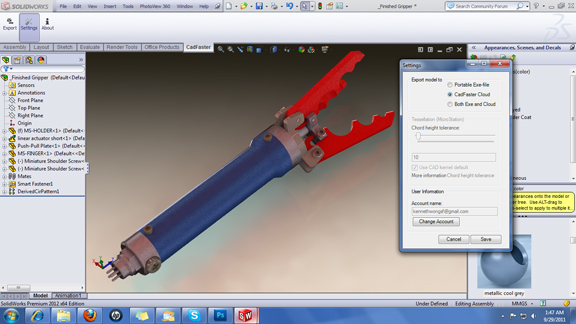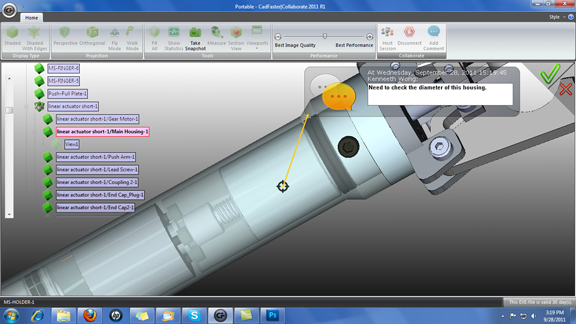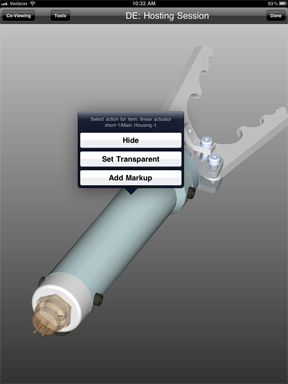September 29, 2011
A couple of years ago, CAD users relied on thin clients and desktop applets to share digital design data with colleagues and collaborators who had little or no need for mechanical modeling software. With smaller footprint and lower learning curve, these viewers were ideal for people who needed to inspect, approve, or comment on engineering documents. They were the preferred alternatives to full-fledged CAD packages.
But the popularity of mobile devices, led by the iPad’s rapid rise, is shaking up the markup market. Household names in CAD—including Autodesk, Dassault Systemes, PTC, and Siemens PLM Software—are embracing tablets and smartphones as the future of collaboration. Many have released their own iPad apps. Those who haven’t are furiously developing one.
You can add CadFaster, developed by a relative newcomer (the company was founded in 2009), into the mix of early iPad apps. Unlike many of its rivals, CadFaster takes into account what you do on your desktop as well as the iPad, then bridges the operations with cloud-hosted data syncing.
The software works as a plug-in to several 3D modelers, including SolidWorks. The plug-in is complemented by an iPad app, called CadFaster Collaborate. Once the plug-in is installed, you may use the CadFaster tab in SolidWorks to convert a 3D assembly model into an executable file—a lightweight 3D file with a self-contained program for viewing and markup. In other words, you do not need a desktop client to view the exported file; a simple double-click will launch the file, along with its own interface for viewing and annotation.
You may also use CadFaster to upload the lightweight model to a cloud server, accessible from the iPad app. Initially, you get 100 MB of storage space. If you’re working with assemblies with hundreds of components, you will undoubtedly fill up the 100 MB quota. CadFaster believes users will willingly pay a nominal fee to get additional storage.
Launching the executable file on a local desktop machine, you can view your model in cross-sections, study its internal components, add comments to it, or take measurements on it. You may also initiate a co-viewing session, which allows you and your collaborator to go online and look at the same model together in real time. With this method, you can easily invite someone to review and comment on a design from an iPad, in a collaboration session that facilitates both the desktop user and the tablet user. In a co-viewing session, the host takes control of the operations (so the host can, for example, set the transparency of a part to reveal its internal structure), but the guest sees the same view the host sees. At any given moment, the host may pass control over to the guest. (This method is a bit different from AutoCAD WS’s co-viewing, where both parties may zoom and pan a shared DWG file, add comments, and use editing tools simultaneously.)
In CadFaster for the iPad, you can do pretty much everything you can do with the executable file. Perhaps more important, CadFaster synchronizes comments between desktop and mobile apps, so if you add a comment on a shared document from your desktop, your collaborator who launches the same file on his or her iPad receives an alert, along with your comment.
CadFaster developers have discovered that, with certain antivirus software, the executable file might trigger unwarranted security alerts. With some overprotective antivirus software, the file may not launch at all. For those reasons, CadFaster is considering replacing the executable file with a thin client for the desktop.
The first release of CadFaster for iPad contains a few quirks in its interface. For instance, the display doesn’t reorient itself when you switch the iPad’s orientation from portrait to landscape mode. The comments currently appear under the same tap, as a series of thumbnail images with texts. To make it easier for people juggling multiple discussion threads and models, CadFaster may need to give users the option to organize comments by associated models, by dates, by comment-author names, or some other means.
In its use to cloud-hosted data syncing, CadFaster is following the example of successful eBook reader apps, like the Amazon Kindle app. When reading an ebook, readers may use a mix of platforms (Kindle for PC, Kindle for iPad, Kindle for iPhone, or on the Kindle device itself). Kindle apps’ ability to synchronize among themselves in the cloud ensures that readers see the same annotations and highlights, regardless of the device they’re using to access their digital content. Similarly, CadFaster is bridging users’ desktop operations and mobile operations, paving the way for collaboration across multiple devices.
For a demonstration of CadFaster, watch the video below.
Subscribe to our FREE magazine, FREE email newsletters or both!
About the Author
Kenneth Wong is Digital Engineering’s resident blogger and senior editor. Email him at [email protected] or share your thoughts on this article at digitaleng.news/facebook.
Follow DE








